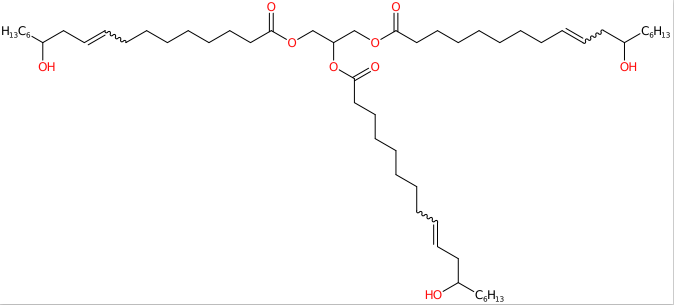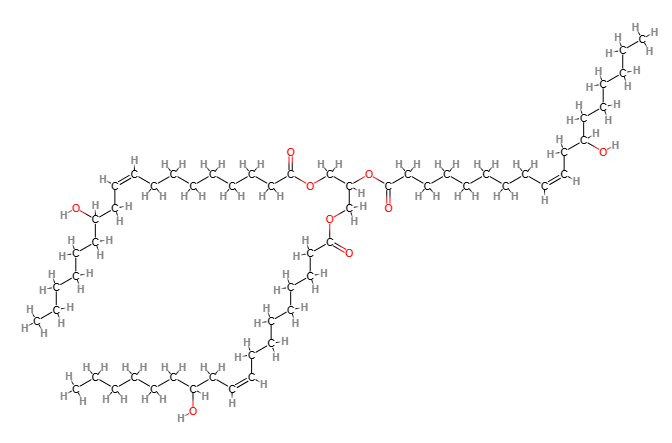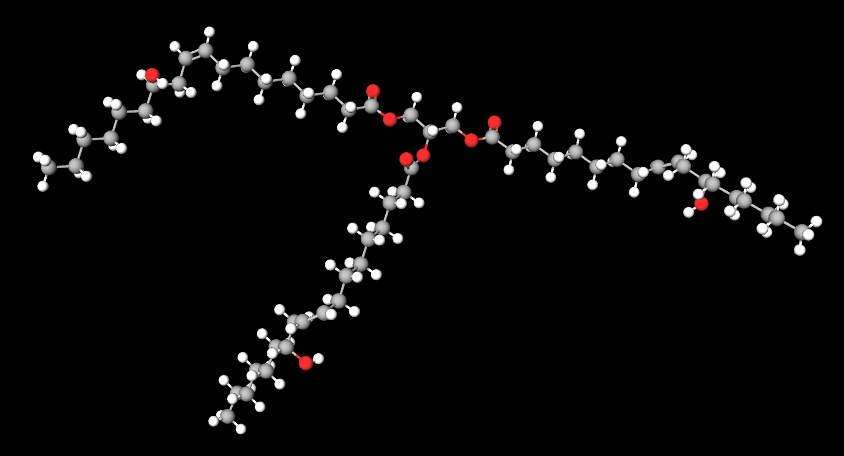![]() Ricinus communis (Castor) seed oil
Ricinus communis (Castor) seed oil
Rating : 7
| Evaluation | N. Experts | Evaluation | N. Experts |
|---|---|---|---|
| 1 | 6 | ||
| 2 | 7 | ||
| 3 | 8 | ||
| 4 | 9 | ||
| 5 | 10 |
10 pts from Street82
| Sign up to vote this object, vote his reviews and to contribute to Tiiips.Evaluate | Where is this found? |
| "Ricinus communis seed oil studies" about Ricinus communis (Castor) seed oil Review Consensus 10 by Street82 (2970 pt) | 2022-Oct-16 18:47 |
| Read the full Tiiip | (Send your comment) |
Compendium of the most significant studies with reference to properties, intake, effects.
Final report on the safety assessment of Ricinus Communis (Castor) Seed Oil, Hydrogenated Castor Oil, Glyceryl Ricinoleate, Glyceryl Ricinoleate SE, Ricinoleic Acid, Potassium Ricinoleate, Sodium Ricinoleate, Zinc Ricinoleate, Cetyl Ricinoleate, Ethyl Ricinoleate, Glycol Ricinoleate, Isopropyl Ricinoleate, Methyl Ricinoleate, and Octyldodecyl Ricinoleate. Int J Toxicol. 2007;26 Suppl 3:31-77. doi: 10.1080/10915810701663150.
Abstract. The oil derived from the seed of the Ricinus communis plant and its primary constituent, Ricinoleic Acid, along with certain of its salts and esters function primarily as skin-conditioning agents, emulsion stabilizers, and surfactants in cosmetics, although other functions are described. Ricinus Communis (Castor) Seed Oil is the naming convention for castor oil used in cosmetics. It is produced by cold pressing the seeds and subsequent clarification of the oil by heat. Castor oil does not contain ricin because ricin does not partition into the oil. Castor oil and Glyceryl Ricinoleate absorb ultraviolet (UV) light, with a maximum absorbance at 270 nm. Castor oil and Hydrogenated Castor Oil reportedly were used in 769 and 202 cosmetic products, respectively, in 2002; fewer uses were reported for the other ingredients in this group. The highest reported use concentration (81%) for castor oil is associated with lipstick. Castor oil is classified by Food and Drug Administration (FDA) as generally recognized as safe and effective for use as a stimulant laxative. The Joint Food and Agriculture Organization (FAO)/World Health Organization (WHO) Expert Committee on Food Additives established an acceptable daily castor oil intake (for man) of 0 to 0.7 mg/kg body weight. Castor oil is hydrolyzed in the small intestine by pancreatic enzymes, leading to the release of glycerol and Ricinoleic Acid, although 3,6-epoxyoctanedioic acid, 3,6-epoxydecanedioic acid, and 3,6-epoxydodecanedioic acid also appear to be metabolites. Castor oil and Ricinoleic Acid can enhance the transdermal penetration of other chemicals. Although chemically similar to prostaglandin E(1), Ricinoleic Acid did not have the same physiological properties. These ingredients are not acute toxicants, and a National Toxicology Program (NTP) subchronic oral toxicity study using castor oil at concentrations up to 10% in the diet of rats was not toxic. Other subchronic studies of castor oil produced similar findings. Undiluted castor oil produced minimal ocular toxicity in one study, but none in another. Undiluted castor oil was severely irritating to rabbit skin in one study, only slightly irritating in another, mildly irritating to guinea pig and rat skin, but not irritating to miniature swine skin. Ricinoleic Acid was nonirritating in mice and in one rabbit study, but produced well-defined erythema at abraded and intact skin sites in another rabbit study. Zinc Ricinoleate was not a sensitizer in guinea pigs. Neither castor oil nor Sodium Ricinoleate was genotoxic in bacterial or mammalian test systems. Ricinoleic Acid produced no neoplasms or hyperplasia in one mouse study and was not a tumor promoter in another mouse study, but did produce epidermal hyperplasia. Castor oil extract had a strong suppressive effect on S(180) body tumors and ARS ascites cancer in male Kunming mice. No dose-related reproductive toxicity was found in mice fed up to 10% castor oil for 13 weeks. Female rats injected intramuscularly with castor oil on the first day after estrus had suppressed ovarian folliculogenesis and anti-implantation and abortive effects. Castor oil used as a vehicle control in rats receiving subcutaneous injections had no effect on spermatogenesis. A methanol extract of Ricinus communis var. minor seeds (ether-soluble fraction) produced anti-implantation, anticonceptive, and estrogenic activity in rats and mice. Clinically, castor oil has been used to stimulate labor. Castor oil is not a significant skin irritant, sensitizer, or photosensitizer in human clinical tests, but patients with occupational dermatoses may have a positive reaction to castor oil or Ricinoleic Acid. The instillation of a castor oil solution into the eyes of nine patients resulted in mild and transient discomfort and minor epithelial changes. In another study involving 100 patients, the instillation of castor oil produced corneal epithelial cell death and continuity breaks in the epithelium. Because castor oil contains Ricinoleic Acid as the primary fatty acid group, the Cosmetic Ingredient Review (CIR) Expert Panel considered the safety test data on the oil broadly applicable to this entire group of cosmetic ingredients. The available data demonstrate few toxic effects. Although animal studies indicate no significant irritant or sensitization potential, positive reactions to Ricinoleic Acid in selected populations with identified dermatoses did suggest that sensitization reactions may be higher in that population. Overall, however, the clinical experience suggests that sensitization reactions are seen infrequently. In the absence of inhalation toxicity data on these ingredients, the Panel determined that these ingredients can be used safely in aerosolized cosmetic products because the particle sizes produced are not respirable. Overall, the CIR Expert Panel concluded that these cosmetic ingredients are safe in the practices of use and concentrations as described in this safety assessment.
Kelly AJ, Kavanagh J, Thomas J. Castor oil, bath and/or enema for cervical priming and induction of labour. Cochrane Database Syst Rev. 2013 Jul 24;2013(7):CD003099. doi: 10.1002/14651858.CD003099.pub2.
Abstract. Background: Castor oil, a potent cathartic, is derived from the bean of the castor plant. Anecdotal reports, which date back to ancient Egypt have suggested the use of castor oil to stimulate labour. Castor oil has been widely used as a traditional method of initiating labour in midwifery practice. Its role in the initiation of labour is poorly understood and data examining its efficacy within a clinical trial are limited. This is one of a series of reviews of methods of cervical ripening and labour induction using standardised methodology. Objectives: To determine the effects of castor oil or enemas for third trimester cervical ripening or induction of labour in comparison with other methods of cervical ripening or induction of labour.....Authors' conclusions: The three trials included in the review contain small numbers of women. All three studies used single doses of castor oil. The results from these studies should be interpreted with caution due to the risk of bias introduced due to poor methodological quality. Further research is needed to attempt to quantify the efficacy of castor oil as an cervical priming and induction agent.
Omotehinse, S. A., & Omidih, L. A. (2021). A Review of Studies on Castor Seed (Ricinus Communis L.) Shrub and Potential Utilization of its Oil. In BOOK OF PROCEEDINGS (p. 72).
Abstract. Castor bean plant (Ricinus Communis L.) is one of the oldest cultivated crops, but at present the oil produced from the seed represents only 0.15% of the vegetable oil produced in the world. Castor seed is an industrial oilseed crop belonging to the Euphorbiaceae family, widespread in the tropical region as a spontaneous plant, having its main cultivated area in India, China, and Brazil. As a crop, the main advantage of castor is its tolerance to drought stress and adaptation to several growing conditions. As an industrial product, castor oil composition is different in many respects from any other oil because it consists largely (up to 90%) of the unusual ricinoleic fatty acid. This review was conducted to provide a collation of the most relevant historic research information published by global community of researchers and define the remarkable future potential of castor seed oil. This article was also prepared to give a general overview of the industrial and domestic importance of castor seed oil to the world at large. The topics discussed in this review include: (i) Applications of castor seed oil in various field of study; (ii) phytochemical studies on Castor bean; (iii) Pharmacological studies on Castor bean; (iv) Evaluation of previous research; (v) Nature of existing research; (vi) Merit of previous studies; (vii) Potential and challenges of castor seed oil production. It is the belief of the author that this review will serve as a baseline for researchers who intend to venture into castor seed oil production.

Goswami D, Sen R, Basu JK, De S. Maximization of bioconversion of castor oil into ricinoleic acid by response surface methodology. Bioresour Technol. 2009 Sep;100(18):4067-73. doi: 10.1016/j.biortech.2008.11.040.
Abstract. In this study, response surface methodology was applied to optimize process variables like temperature, pH, enzyme concentration (mg/g oil), and buffer concentration (g/g oil) for hydrolysis of castor oil using Candida rugosa lipase. A 2(4) full factorial central composite design was used to develop the quadratic model that was subsequently optimized and the optimal conditions were as follows: temperature 40 degrees C, pH 7.72, enzyme concentration 5.28 mg/g oil, buffer concentration 1g/g oil and there was 65.5% conversion in 6 h. These predicted optimal conditions agreed well with the experimental results. This is the first report on the application of response surface methodology in castor oil hydrolysis using C. rugosa lipase with higher percentage conversion in 6 h.
Subramaniyan, V. (2020). Therapeutic importance of caster seed oil. In Nuts and Seeds in Health and Disease Prevention. Academic Press.
Abstract. Castor oil is derived from castor beans and has a variety of health benefits. It can be used against eye infection, liver disorders, and sexually transmitted diseases. Castor beans play an important commercial role in the preparations of soaps, coating and lubricating agents, etc. Moreover, castor seed oil has an important role in preparation of pharma products and pesticide preparation. It is widely cultivated and naturalized in tropical and subtropical regions of America, many temperature areas of Europe, and India. In South India, the Tamil local name is amanakku. Castor seed oil is a rich source of ricinoleic acid and triglycerides, which are valuable for therapeutic aspects. There are multiple uses of castor oil including germicidal agents, disinfectant, and purgative. In order to increase the utility of the castor oil, there is a need for further scientific investigation toward therapeutic safety.
Scarpa A, Guerci A. Various uses of the castor oil plant (Ricinus communis L.). A review. J Ethnopharmacol. 1982 Mar;5(2):117-37. doi: 10.1016/0378-8741(82)90038-1.
Abstract. The ancient and modern medicinal uses of the castor bean plant, Ricinus communis L. (Euphorbiaceae), in about fifty countries worldwide, has been surveyed. The different medicinal uses are grouped separately in relation to their pharmacological action, whether real or presumed, within the various medical specialities. The results show an extensive use of this plant throughout the world and the authors suggest that further research should be carried out to determine the active principles present in the various parts of the plant.
| Sign up to vote this object, vote his reviews and to contribute to Tiiips.EvaluateClose | (0 comments) |
| "Descrizione" about Ricinus communis (Castor) seed oil Review Consensus 10 by Street82 (2970 pt) | 2023-Feb-15 09:58 |
| Read the full Tiiip | (Send your comment) |
Ricinus communis seed oil is a vegetable oil obtained by cold pressing or other methods of extraction (chemical or solvent extraction using n-hexane and supercritical carbon dioxide, aqueous and reactive enzymatic accompanied by ultrasound) of the seeds of Ricinus communis L., (oil content approximately 35%-56%) an annual herbaceous plant belonging to the Euphorbiaceae family. It is composed of ricinoleic acid, a hydroxylated fatty acid, carotenoids, tocopherols and other interesting constituents.
It appears as a white powder or a viscous, transparent yellowish liquid. May be sensitive to light. Flammable. Incompatible with strong oxidising agents. Insoluble in water, insoluble in mineral oil unless mixed with another vegetable oil. Mixable with ethanol, chloroform, diethylether, acetic acid and methanol.


What it is used for and where
Medical
Castor oil has been used by traditional medical science as a purgative and as a method of initiating labour in obstetrical practice. Ricinus communis contains 80-90% ricinoleic acid and, among other applications, is used as a co-polyester of ricinoleic-lactic acid as a drug carrier (1) and has demonstrated anti-inflammatory, bactericidal and anti-herpetic properties (2).
Cosmetics
At the origin of synthetic surfactants Turkey Red Oil was the first on the market and was and still is the sulphated product of castor oil, still used today in the processing and tanning of leather, textiles and in some cosmetic applications.
Castor oil is added to cold-processed soap formulations to increase lather, added to shampoos and conditioners to treat brittle hair and add volume. Its high viscosity and miscibility with both polar and non-polar compounds make it especially interesting added in small amounts in lipsticks. It has a non-comedogenic skin interaction so it does not create unwanted films on the skin and this quality is the reason why it is popular in skin-improving creams. Cleansers containing castor oil have emulsifying properties.
Skin conditioning agent. An ingredient that is the mainstay of topical skin treatment by restoring, increasing or improving skin tolerance to external factors, including melanocyte tolerance. The most important function of the conditioning agent is to prevent skin dehydration, but the subject is rather complex and involves emollients and humectants.
Fragrance. It plays a very important role in the formulation of cosmetic products as it allows perfume to be enhanced, masked or added to the final product, improving its commercial viability. The consumer always expects to find a pleasant scent in a cosmetic product.
In powder form it is hydrogenated and is an emulsifying agent.

Insecticides
Castor oil has shown some potential in the practical control of both immature and adult stages of the mosquito vector, particularly against the important dengue vector, Aedes aegypti, and has been tested for macrophilicidal activity against adults of Setaria digitata a parasitic nematode found in the peritoneal cavity of cattle. The toxicity of methanol, ethyl acetate, chloroform and petroleum ether extracts of the leaf of R. communis was tested against third stage Musca domestica larvae (Singh & Kaur, 2016). Crude methane extracts of R. communis leaves showed moderate acaricidal and insecticidal activity against Haemaphysalis bispinosa and Hippobosca maculate (Zahir et al., 2010a) (3).
Other Uses
Used to produce polyurethane coatings, rubber, dicarboxylic acid, plasticisers and various types of oil such as insulating oil, Turkish red oil, hydraulic oil. It is also used to produce polyamide-11 fibre and soap.
In the leather industry it serves as a greasing agent, extender and bleaching agent for finishing.
In the textile industry it is a penetrating and emulsifying agent.
When dehydrated, a conjugated dry double bond oil is obtained.
Safety
In 2007, the CIR (Cosmetic Ingredient Review) Expert Group suggested that sensitisation reactions were rarely observed and this ingredient can be used safely in cosmetic products even when aerosolised because the particle sizes produced are not respirable. Overall, the CIR Expert Panel concluded that this cosmetic ingredient is safe in the use practices and concentrations described in this safety assessment (4).
For more information:
Typical commercial product characteristics Castor seed oil
| Appearance | White powder or colorless or slight yellow liquid |
| Boiling Point | 879.2±65.0°C at 760 mmHg |
| Melting Point | -12ºC |
| Flash Point | 224.1±27.8°C |
| Freezing Point | -10℃ |
| Density | 1.0±0.1 g/cm3 |
| Relative density | 0.956 ~ 0.969 |
| Refraction Index | 1.490 |
| Vapor Pressure | 0.0±0.6 mmHg at 25°C |
| PSA | 139.59000 |
| LogP | 17.72 |
| Water Solubility | <0.1 g/100 mL at 20 ºC |
| Refractive Rate | n20/D1.478(lit.) |
| Autogenous Ignition | 449°C (liquid) |
| Relative density | 0.956 ~ 0.969 (liquid) |
| Shelf Life | 24 months |
 |  |
 |  |
- Molecular Formula C57H104O9
- Molecular Weight 933.4
- Exact Mass 932.768005
- CAS 8001-79-4
- UNII D5340Y2I9G
- EC Number 232-293-8
- DSSTox Substance ID DTXSID7024742
- IUPAC 2,3-bis[[(Z)-12-hydroxyoctadec-9-enoyl]oxy]propyl (Z)-12-hydroxyoctadec-9-enoate
- InChl=1S/C57H104O9/c1-4-7-10-31-40-51(58)43-34-25-19-13-16-22-28-37-46-55(61)64-49-54(66-57(63)48-39-30-24-18-15-21-27-36-45-53(60)42-33-12-9-6-3)50-65-56(62)47-38-29-23-17-14-20-26-35-44-52(59)41-32-11-8-5-2/h25-27,34-36,51-54,58-60H,4-24,28-33,37-50H2,1-3H3/b34-25-,35-26-,36-27-
- InChl Key ZEMPKEQAKRGZGQ-AAKVHIHISA-N
- SMILES CCCCCCC(CC=CCCCCCCCC(=O)OCC(COC(=O)CCCCCCCC=CCC(CCCCCC)O)OC(=O)CCCCCCCC=CCC(CCCCCC)O)O
- MDL number MFCD00130746
- PubChem Substance ID
- RTECS FI4100000 YX1850000
- FEMA 2263
- NCI C80990
- ICSC 1452
Synonyms:
- Ricinus oil
- Castor oil
- Olio di ricino
References_______________________________________________________________________
(1) Slivniak, R.; Ezra, A.; Domb, A.J. Hydrolytic degradation and drug release of ricinoleic acid-lactic acid copolyesters. Pharm. Res. 23, 1306-1312 (2006)
(2) Gamayurova, V.S.; Zinov’Eva, M.E.; Tran, H.T.T. Features of the enzymatic hydrolysis of castor oil. Catal. Ind. 5, 269-273 (2013).
(3) Wamaket N, Dieng H, Komalamisra N, Apiwathnasorn C, Morales RE, Thanomsub BW, Srisawat R, Attrapadung S. Larvicidal and adulticidal activities of castor oil against the dengue vector, Aedes aegypti. Trop Biomed. 2018 Sep 1;35(3):610-618.
(4) Final report on the safety assessment of Ricinus Communis (Castor) Seed Oil, Hydrogenated Castor Oil, Glyceryl Ricinoleate, Glyceryl Ricinoleate SE, Ricinoleic Acid, Potassium Ricinoleate, Sodium Ricinoleate, Zinc Ricinoleate, Cetyl Ricinoleate, Ethyl Ricinoleate, Glycol Ricinoleate, Isopropyl Ricinoleate, Methyl Ricinoleate, and Octyldodecyl Ricinoleate. Int J Toxicol. 2007;26 Suppl 3:31-77. doi: 10.1080/10915810701663150.
| Sign up to vote this object, vote his reviews and to contribute to Tiiips.EvaluateClose | (0 comments) |
Read other Tiiips about this object in __Italiano (2)
Component type: Natural Main substances: Last update: 2024-07-12 08:39:01 | Chemical Risk: |


